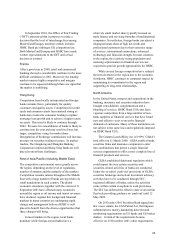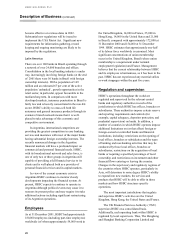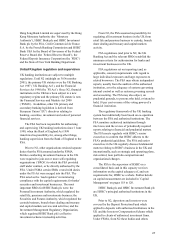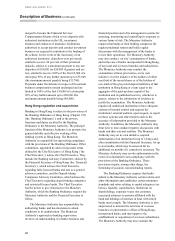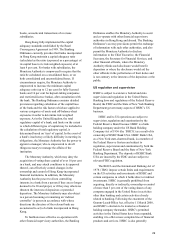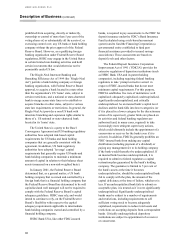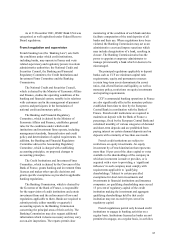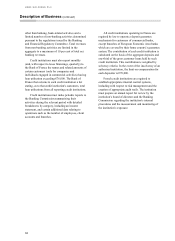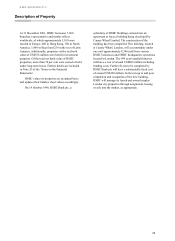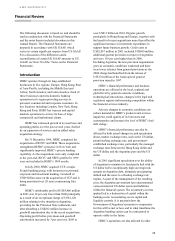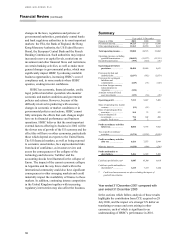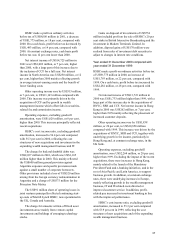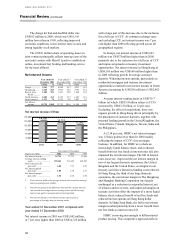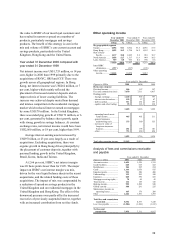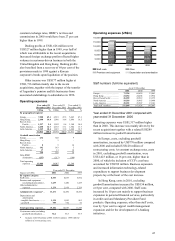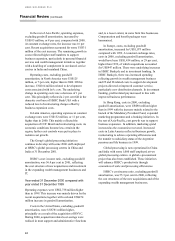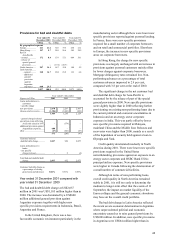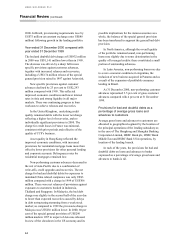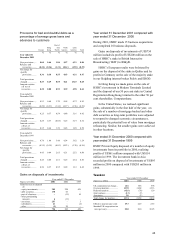HSBC 2001 Annual Report Download - page 37
Download and view the complete annual report
Please find page 37 of the 2001 HSBC annual report below. You can navigate through the pages in the report by either clicking on the pages listed below, or by using the keyword search tool below to find specific information within the annual report.
HSBC HOLDINGS PLC
Financial Review
35
The following discussion is based on, and should be
read in conjunction with the Financial Statements
and the notes thereto included elsewhere in this
Annual Report. The Financial Statements are
prepared in accordance with UK GAAP, which
varies in certain significant respects from US GAAP.
For a discussion of the differences and a
reconciliation of certain UK GAAP amounts to US
GAAP, see Note 50 of the ‘Notes on the Financial
Statements’ .
Introduction
HSBC operates through its long-established
businesses in five regions: Europe; Hong Kong; Rest
of Asia-Pacific, including the Middle East and
Africa; North America; and Latin America. Each of
these businesses operates domestic banking
operations in its region providing services to
personal, commercial and corporate customers. In
key locations including London, New York, Hong
Kong and Paris, HSBC has treasury and capital
markets operations to service its base of large
commercial and institutional clients.
HSBC has witnessed growth in its asset base and
operating profits over the past several years, fuelled
by an expansion of services and an added-value
acquisition strategy.
On 31 December 1999, HSBC completed the
acquisitions of RNYC and SRH. These acquisitions
strengthened HSBC’s presence in New York and
significantly improved HSBC’s private banking
capability. As the acquisitions were only completed
at the year-end, RNYC and SRH’s profits for 1999
were not included in HSBC’s 1999 results.
In July 2000, HSBC acquired CCF, a major
French banking group, with businesses in personal,
corporate and investment banking. Goodwill of
US$9 billion arose on the acquisition of CCF and is
being amortised over 20 years commencing July
2000.
HSBC’s attributable profit of US$5,406 million
in 2001 was 18 per cent lower than 2000 principally
as a result of an exceptional charge of US$1,120
million relating to the situation in Argentina,
providing for the Princeton Note settlement, and
after absorbing a US$282 million increase in
goodwill amortisation due to the recent acquisitions.
Operating profit before provisions and goodwill
amortisation increased by 3 per cent over 2000 to
over US$11 billion in 2001. Organic growth,
particularly in Hong Kong and Europe, together with
the benefit of recent acquisitions more than offset the
significant increase in investment expenditure to
support future business growth. Credit costs at
US$2,037 million in 2001 included US$600 million
additional general provision in respect of Argentina
and were 119 per cent higher than in 2000.
Excluding Argentina, the new provision requirements
grew as economic conditions weakened and there
were lower releases from general provisions as the
2000 charge had benefited from the release of
US$174 million of the Asian special general
provision raised in 1997.
HSBC’s financial performance and business
operations are affected at the local, regional and
global level by general economic conditions,
technological innovations, changes in the legal and
regulatory regime and increasing competition within
the financial services industry.
Adverse changes in economic conditions can
reduce demand for HSBC’s products and services,
impair the credit quality of its borrowers and
counterparties and increase the level of HSBC’s bad
debt charge.
HSBC’s financial performance can also be
affected by both actual changes in, and speculation
about, market exchange rates, such as the US dollar-
pound sterling exchange rate, and government-
established exchange rates, particularly the managed
exchange rates between the Hong Kong dollar and
the US dollar, and the Argentine peso and the US
dollar.
In 2001 significant speculation over the ability
of Argentina to maintain its fixed parity link with the
US dollar led to exceptionally high sovereign risk
spreads on Argentine debt, ultimately precipitating
default and the move to a floating exchange rate
regime. As part of the management of the resulting
crisis the Argentine government has redenominated
various historical US dollar assets and liabilities
within the financial system. The asymmetry in rates
applied led to a destruction of capital within the
banking sector necessitating severe capital and
liquidity controls. It is uncertain how the
Government of Argentina’s promise to compensate
for this will be met or how and in what timeframe the
Argentine banking system can be restructured to
operate viably in the future.
HSBC’s operations are also affected by other


